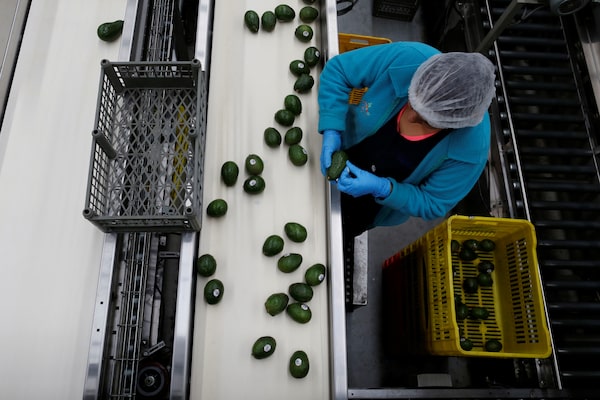Simon Somogyi is the Arrell Chair in the Business of Food at the Gordon S. Lang School of Business and Economics, University of Guelph.
Andrew Nixon is a PhD student at the Gordon S. Lang School of Business and Economics, University of Guelph.
Kimberly Thomas-Francois is a postdoctoral fellow, Gordon S. Lang School of Business and Economics, University of Guelph.

An employee selects avocados to pack in the Global Fruit Packing Company in Uruapan, in Michoacan state, Mexico, on Jan. 31, 2017.Carlos Jasso/Reuters
Trouble at the U.S.-Mexico border will mean higher fruit and vegetable prices for Canadians.
Each month, millions of Canadians enter our grocery stores and purchase approximately $7-billion worth of fruit, vegetable, meat and packaged food products feeding the 37 million people that live in our country. To the outsider, it may appear that the family-controlled grocery conglomerates such as Loblaw, Sobeys and Metro hold the power over our wallets and food plates, but increasingly, those concerns are being linked to a looming disquiet in our food-retail sector, and it surrounds U.S. President Donald Trump.
Mr. Trump has been in the headlines in the past year calling for major changes to how Canada runs its food system. He has taken aim at the Canadian supply-managed food sectors, such as dairy, poultry and eggs, and holding steel and other Canadian exports as bargaining chips in his battle on free trade and the U.S.-Mexico-Canada Agreement. For now, he has won on that. But the greater concern is not related to our trade agreements, nor specifically U.S.-Canadian relations, but with the U.S.-Mexico border and particularly the flow of food products from Mexico to Canada through the United States.
Canada imports approximately $36-billion worth of products from Mexico including $2-billion in fruit and vegetables, products such as tomatoes, peppers, cucumbers, asparagus and our perennial favourite: avocados. Approximately 25 per cent of all fresh fruits and vegetable imports into Canada originate from Mexico, increasing in the cooler months of the year, when we are unable to produce those commodities. The closing of the U.S.-Mexico border would have a major, lasting impact on our fruit and vegetable prices. Some estimates from the United States suggest that if the border were to close, grocery-store prices in the United States for fruit and vegetable products would increase by 20 per cent to 40 per cent and the flow-on effect to Canada would be even worse as U.S. retailers soak up American fruit and vegetable production that would otherwise go to Canada.
But a complete shutdown is unlikely, with Mr. Trump recently stating that he’s giving a “one-year warning.” The U.S. National Farmers Union, one of Mr. Trump’s stronger allies, is asking for him to cool his rhetoric on closing the border and have further concerns that the nationalist sentiments of his trade policies are creating a loss of markets that have taken decades to develop, leading to a lowering of farm-gate prices.
But “trouble at the border” is having a greater, more insidious impact, which threatens Canadian food security and food prices: slowdown.
US$1.7-billion in trade crosses the U.S.-Mexico border every day and crossings at that border are slowing down. Fruit- and vegetable-laden trucks would normally spend a few hours at the border; now, it is not uncommon for trucks to take days to cross. All the while, the fruit and vegetables in those trucks are slowing perishing, affecting their quality and nutritional value by the time they make their way across the United States into Canada. The subtle effect of this slowdown is already being seen with recent Canadian consumer price index figures showing a 15.7-per-cent increase in the price of fruit and vegetables in the past year, with logistics slowdowns being a contributing factor.
The disquiet at the border and endless freight slowdowns are causing headaches for our food-retailing sector, envisioning nightmare scenarios of “dollar-a-piece” tomatoes or products with reduced shelf life. Canadian grocers and logistics companies are currently hedging their bets and investigating alternative shipping arrangements, using sea freight from Mexico to Vancouver or ports on the Canadian East Coast. These options are slower than a truck but potentially quicker and a safer bet.
In Canada, we ceaselessly discuss food security and, owing to our geographical location, we rely on our southern neighbours to provide us with the food that we eat every day. Our greenhouse and indoor-farming sector are salivating at the potential high prices that reduced supply in the market from border shutdowns or slowdowns could provide. But with one in eight Canadian households experiencing food insecurity and with food prices in Canada increasing year over year, perhaps it’s time we consider the greater ramifications of a Canadian food system that relies more on itself than others.